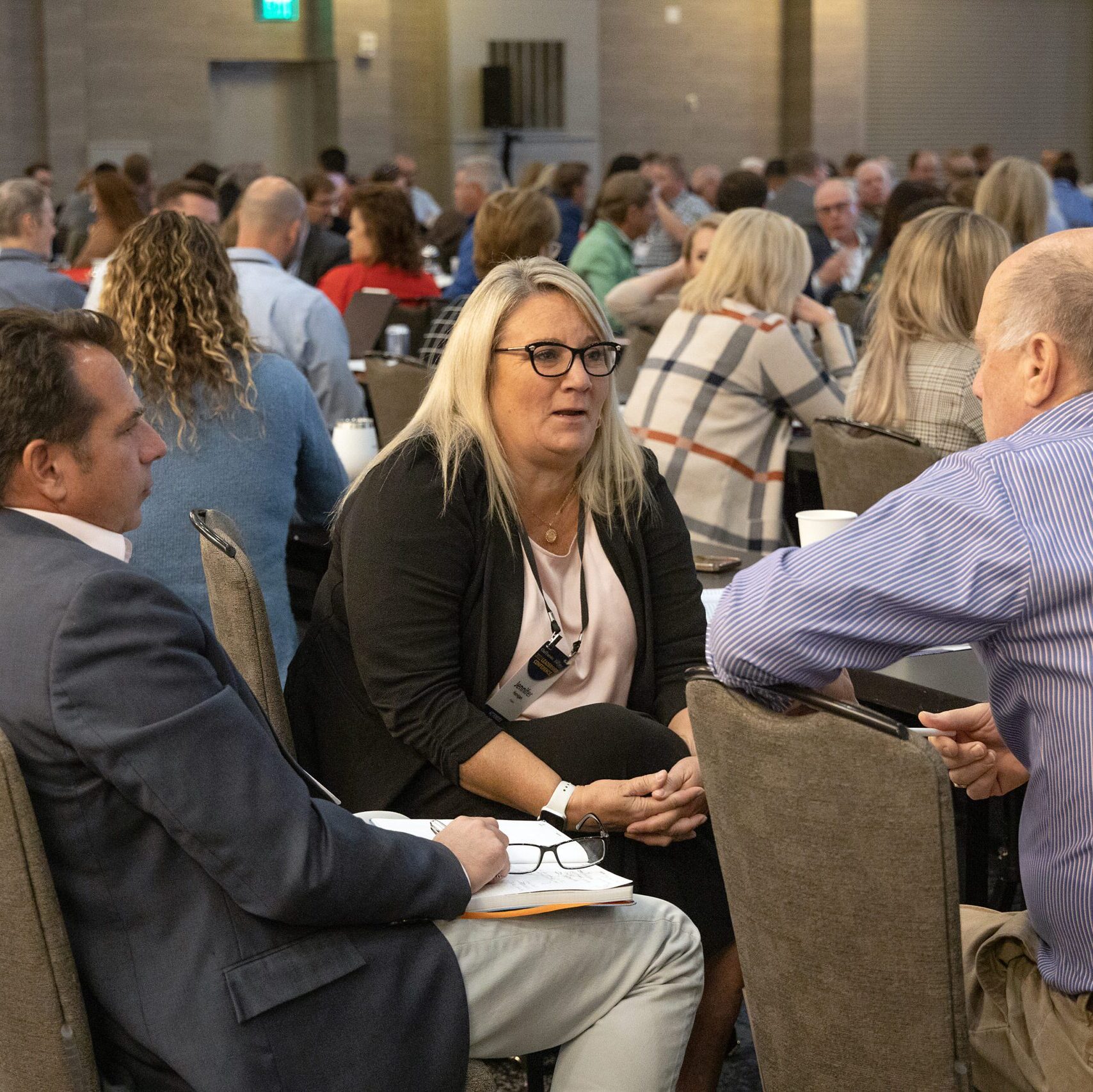Corporate leaders no longer need to be convinced that artificial intelligence is a strategic priority with the power to reshape how businesses operate and grow. But how far along are they in turning that belief into action? A new survey by Chief Executive, conducted in partnership with Salesforce, offers a snapshot of how leaders are navigating AI adoption—from early experimentation to more structured deployment across core functions.
The results paint a nuanced picture: Most CEOs recognize AI’s importance but find themselves navigating uncertainty rather than clear-cut roadmaps. Of the nearly 330 CEOs surveyed, only 13 percent said their AI strategies were clearly defined and well-established. A far larger group—37 percent—admitted their AI plans resemble a “moving goalpost,” continuously evolving as new developments emerge. The biggest cohort, at 42 percent, acknowledged they’re merely exploring possibilities, not yet committing fully to a strategic path, and 8 percent of CEOs said they are completely sidelining AI, at least for now.
To help bridge the gap between aspiration and execution, a new class of AI is fast emerging: agentic AI. Unlike traditional AI, which automates narrowly defined tasks, agentic AI empowers software agents to make decisions, take initiative and act with a degree of autonomy—always within enterprise-defined boundaries. This next-generation approach is designed to extend the capabilities of the workforce, not replace them.
Salesforce’s Agentforce platform is built around this idea, enabling AI agents to understand goals, take multi-step actions and learn from outcomes. Embedded across business units—from sales and service to marketing and HR—this “digital workforce” helps teams work faster and smarter, surfacing insights, recommending next steps and even handling entire workflows.
For CEOs, this marks a seismic shift from static automation to intelligent autonomy. “Our sales productivity doubled in the last five months,” says Elia Wallen, CEO of Engine, a corporate travel platform that has adapted agentic AI into operations already through the use of Salesforce’s Agentforce platform. “There are several factors behind that, but AI and automation played a huge role.”
While optimism about AI’s potential is widespread, most companies are still in the early stages of implementation. Just 27 percent of CEOs surveyed say they’ve piloted an agentic AI solution. But among those who have, the results are encouraging: 60 percent say they are somewhat satisfied, and an additional 28 percent report they’re extremely satisfied with the results.
Many organizations are proceeding thoughtfully, launching limited pilots or exploratory projects as they build internal expertise. “We’re going very slowly because I want to make sure this is extremely safe for what we’re doing,” says Brian Glass, CIO of telehealth company Transcend. One of the early tasks AI agents are taking on is order validation. “If they catch even one out of every 10 issues, and that reduces a human’s need to review something, I consider that a success.”
Still, the productivity improvements can be substantial, especially when AI is embedded into core workflows, says Salesforce’s Haley Gault, who estimates Agentforce saves her between 90 minutes and two hours every day. “Before AI I’d be on YouTube searching ‘What does a plastic particle manufacturer do?’ just to be able to talk intelligently about a new prospect’s business,” she says. “Now, I ask Agentforce and it pulls accurate data from Salesforce, Slack and our internal tools. It’s night and day.”
When Travis Gibson, CTO of Big Brothers Big Sisters of America, first explored AI, the nation’s largest youth mentoring organization faced several critical operational challenges.
“We had three main goals,” Gibson explains. “One was to reduce our time to match. The second, even more important, was to improve match quality. The third is to relieve our staff from low value repetitive tasks.” Previously, BBBSA’s matching specialists manually reviewed application details, interview notes, and assessments to identify compatibility between volunteers (“Bigs”) and youths (“Littles”). The process was cumbersome and anxiety-provoking, given the high stakes involved.
Agentforce, Salesforce’s AI solution, significantly streamlined this process. “Now, it provides a summarized history for both parties, highlights key alignment areas, flags concerns, and even drafts a suggested match rationale,” Gibson says. Yet, he emphasizes, “the final decision remains in the hands of our staff, who are the experts in making long-lasting matches.”
He views AI tools as “autonomous digital counterparts” supporting human empathy and judgment. “AI is there to alleviate mundane, repetitive tasks, leaving high-value interactions for our humans.”
While still early in its AI journey, BBBSA has seen tangible improvements. “Staff report fewer hours spent per match and increased confidence in their decisions,” Gibson notes. AI’s ability to distill complex data into actionable insights has reduced anxiety around critical matching decisions. “Our people care deeply about creating lifelong, impactful relationships,” he adds. “AI increases their confidence because recommendations are backed by insights.”
The new AI also incorporates predictive analytics to forecast match duration, based on historical data. “Objectively predicting match longevity is a new capability,” Gibson points out, adding that it integrates criteria from rigorous external studies.
Given the sensitive nature of BBBSA’s work, Gibson took careful steps to address ethical considerations and biases in AI. “Our implementation required close collaboration between our internal team, Salesforce, AI experts and key agency stakeholders,” he says. This rigorous setup ensured transparency standards, ethical use and adherence to established criteria such as shared interests and proximity.
Choosing Salesforce was straightforward, Gibson explains: “Agentforce’s native integration with our existing Salesforce ecosystem reduced complexity significantly.” Gibson prioritizes simplified IT management. “Reducing complexity means reduced costs. As a nonprofit, that’s good stewardship of donor dollars.”
BBBSA will track several clear metrics to measure AI’s success, including reduced matching time, increased match retention and improved outcomes for youth, such as higher lifetime earnings, better graduation rates and reduced risky behaviors.
“We’re reducing manual overhead, unlocking cost savings and scaling our mission—without scaling headcount,” says Gibson. “That’s our benchmark.”
For many executives, hesitation boils down to uncertainty about how to strategically integrate AI, concerns about employee resistance and confusion over regulatory or ethical implications. In fact, 48 percent of CEOs agree that fear of misuse or hallucination remains a serious concern, and 46 percent worry about how to reskill their workforce to keep up with AI. Some are waiting for clearer signs of value from early adopters before fully committing.
Gault hears this often from her SMB clients. “People are afraid of it,” she says. “They’re scared of the unknown. But the idea of what AI could do usually outweighs the worry.”
Trust and transparency are particularly sensitive concerns in sectors like healthcare and youth services. “I have to be very careful with any automated system I put in front of our clients,” says Transcend’s Glass. “We’re not trying to fool anybody. We say ‘You’re working with AI right now, here’s what it can do.’ That explicit communication builds trust.”
At Big Brothers Big Sisters of America, CTO Travis Gibson emphasizes the importance of involving human experts in shaping the AI’s parameters. “People are going to trust the machine more if they understand why it’s making certain recommendations,” he says, “and if they know they had a part in setting up the guardrails.”
The takeaway for CEOs is clear: AI adoption isn’t about blindly chasing technology trends but rather demands deliberate, strategic experimentation aligned with core business objectives.
1. Executive Ownership and Governance. Successful agentic AI implementations aren’t just IT initiatives—they require clear executive ownership:
2. Strategic Data Foundation. Agentic AI is only as good as the data it can access and utilize:
3. Technical Architecture and Integration. The right infrastructure enables agents to work effectively across systems:
4. Talent Development and Change Management. Successful adoption requires both technical skills and cultural adaptation:
5. Measurement and Continuous Improvement. What gets measured gets improved:
Elia Wallen, CEO of Engine, vividly recalls what inspired the travel management company’s move toward AI. It started with an everyday frustration: manual repetitive processes that absorbed valuable employee time and bogged down customer interactions.
“In our business, there are a lot of manual moving parts,” Wallen explains. “Historically, you’d pick up the phone and call the hotel directly, even today, which is kind of wild when we think about 2025.”
Engine implemented Salesforce’s AI-driven Agentforce, naming its new virtual assistant Eva, who is tasked with handling high-volume activities such as reservation cancellations and email triage—previously tedious manual tasks. “Eva sits on top of our inbox and routes tens of thousands of emails monthly,” says Wallen. “She sorts spam, sales, support, urgent and non-urgent requests instantly.”
The AI was initially deployed cautiously, achieving about 80 percent accuracy. Engine closely monitored Eva’s performance, adjusting and refining along the way. “You start small, you start safe, and you measure constantly,” Wallen says. Accuracy steadily climbed into the high 90s, ultimately outperforming human efforts. “Now we’re at a 99 percent match rate, higher than people doing it,” he notes, adding that such tasks are “just monotonous and mind-draining—no one wants to do those.”
Engine, on track to grow from 700 to 1,200 employees this year, reassured its workforce that AI wasn’t about job elimination but rather empowering teams. “Change is scary but people are smart,” says Wallen. Employee acceptance grew as the practical value of AI became clear. “Once they see how AI reduces repetitive tasks, it resonates.”
AI is also reshaping how Engine measures success. According to Wallen, sales productivity doubled in five months, and the team sees room to grow further. “Our sales leaders believe productivity can double again—effectively turning 100 sellers into 200.”
Efficiency gains were similarly significant, with Engine reporting a 15 percent reduction in average handle time across customer interactions. Wallen anticipates annual savings to hit $2 million once fully scaled. “It’s not just making people’s lives easier; it’s delivering answers faster.”
Wallen emphasizes customer satisfaction as a critical benchmark for AI deployment. Engine recently recorded its highest-ever customer satisfaction scores, currently in the low 90s. “Customer satisfaction is our North Star,” Wallen says. “If we can hit that and continue to get these gains and maintain that—that’s the magic number.”
Looking ahead, Engine plans to expand AI’s role significantly. Future innovations include a conversational shopping assistant capable of handling highly specific customer inquiries. “You’ll be able to ask ‘Are the pillows soft? Is there a Michelin-star restaurant nearby?’” Wallen says, describing Engine’s next AI frontier. “There’s a lot we can do.”
Gibson offers a practical framework: “Start small. Find a specific, meaningful avenue where AI can have an impact—whether it’s streamlining operations or improving engagement. Learn, then iterate over time.”
Glass echoes the need for careful onboarding. “You’ve really got to demo this for people before they understand it,” he says. “You can whiteboard this all day, but once you let someone try it—even for 30 minutes—it usually blows them away.”
Gault adds that the learning curve isn’t nearly as steep as many CEOs expect. “They made all of us in sales actually learn to build a bot,” she says. “If I can do it, anyone can.”
Even ethical concerns around hallucination or misinformation are being addressed. “I feel completely confident I can trust [the information] Agentforce gives me because it’s based on our actual Salesforce data—our single source of truth,” Gault says. “It’s not just scraping the internet.”
Looking ahead, CEOs who are still on the sidelines may not want to wait too long. Among those who say they’re planning or considering deployment, nearly 55 percent expect to launch within the next 18 months—with 18 percent expecting to deploy within six months. That suggests the early experimentation phase may soon give way to a new wave of enterprise-scale implementation.
For many companies, the real value of AI isn’t about reducing headcount—it’s about scaling efficiently without adding more people. At BBBSA, it’s about “freeing up humans for higher-value interactions and scaling our network of agencies to more communities,” says Gibson.
CEOs who succeed with agentic AI will balance boldness with prudence, advancing step-by-step to integrate the technology into key functions. The challenge—and opportunity—is finding the sweet spot where technology augments human strengths, delivering measurable business value without sacrificing the irreplaceable element of human judgment.
But with momentum building and success stories multiplying, the future of agentic AI in business is no longer a question of if—but how fast. “It’s not hype,” says Wallen. “The results are real.”
As a CEO understanding this distinction is crucial because agentic AI doesn’t just automate existing processes—it transforms how work gets done by:
For Brian Glass, CIO of telehealth provider Transcend, implementing artificial intelligence wasn’t just about adopting new technology—it was about reshaping how healthcare interacts with patients. Transcend operates in a heavily regulated sector where accuracy and personal interaction are crucial. “Healthcare is confusing for clients and practitioners,” Glass acknowledges. “We see AI as a way to solve a lot of that confusion.”
The company’s goals are clear: more precision, faster turnaround times and, ultimately, better-informed patients. In practical terms, Transcend’s AI strategy leverages Salesforce’s Agentforce to handle complex data integration seamlessly. “We’re working with cutting-edge therapies and things that are not necessarily mainstream, so providing people with information and helping them synthesize that are accelerators for us,” says Glass. “It definitely can be just a chatbot, but it can be a lot more.”
Because AI assists rather than replaces, employee fears of job losses never materialized. “We’re in a field where you can’t necessarily replace people due to regulations,” Glass explains. “AI helps us extend a higher standard of care, making our people more effective.”
Early wins have been encouraging, particularly with mundane tasks like order tracking and client inquiries. “Any time I can save someone those mundane conversations, that’s money in the bank for us,” Glass says. Early success with AI-powered chatbots on Transcend’s client portal has boosted confidence. “We’re unifying all our AI tools based on these initial successes.”
Transcend’s view of ROI moves beyond simple cost reduction. “It’s not tremendously expensive compared to the time we hope to save,” Glass acknowledges, but he views agentic AI primarily as “a revenue multiplier.”
Transcend evaluates AI effectiveness using clear, customer-centric metrics: reduced support calls and emails, increased use of automated order processes and improved patient satisfaction. Glass anticipates that AI will help significantly scale the company’s capabilities. “We’re taking something powerful and extending our reach to many more people than we could without AI,” he says.
Looking ahead, Glass sees AI as a transformative force in healthcare—though always with clear boundaries. “AI is not a doctor and never will be,” he says. “But AI can provide clarity where none exists. It can surface critical insights from massive data—things people often miss.”
Transcend aims to use AI proactively to make connections for patients based on synthesized patient data, diagnostic tests and even wearable health information. “These are some topics that you could talk about with your healthcare provider and maybe some tests that we could suggest that might help separate the signal from the noise,” Glass says, adding that digital labor will ultimately raise the standards of care and improve patient outcomes. “When we give people solutions they’ve never had before, it changes lives.”
KEY ACTIVITIES:
CEO CHECKLIST:
STRATEGIC QUESTIONS TO ASK:
KEY ACTIVITIES:
CEO CHECKLIST:
IMPLEMENATION GUIDANCE:
KEY ACTIVITIES:
CEO CHECKLIST:
STRATEGIC CONSIDERATIONS:
KEY ACTIVITIES:
CEO CHECKLIST:
KEY ACTIVITIES:
CEO CHECKLIST:
FUTURE-LOOKING CONSIDERATIONS:
0

1:00 - 5:00 pm
Over 70% of Executives Surveyed Agree: Many Strategic Planning Efforts Lack Systematic Approach Tips for Enhancing Your Strategic Planning Process
Executives expressed frustration with their current strategic planning process. Issues include:
Steve Rutan and Denise Harrison have put together an afternoon workshop that will provide the tools you need to address these concerns. They have worked with hundreds of executives to develop a systematic approach that will enable your team to make better decisions during strategic planning. Steve and Denise will walk you through exercises for prioritizing your lists and steps that will reset and reinvigorate your process. This will be a hands-on workshop that will enable you to think about your business as you use the tools that are being presented. If you are ready for a Strategic Planning tune-up, select this workshop in your registration form. The additional fee of $695 will be added to your total.

2:00 - 5:00 pm
Female leaders face the same issues all leaders do, but they often face additional challenges too. In this peer session, we will facilitate a discussion of best practices and how to overcome common barriers to help women leaders be more effective within and outside their organizations.
Limited space available.

10:30 - 5:00 pm
General’s Retreat at Hermitage Golf Course
Sponsored by UBS
General’s Retreat, built in 1986 with architect Gary Roger Baird, has been voted the “Best Golf Course in Nashville” and is a “must play” when visiting the Nashville, Tennessee area. With the beautiful setting along the Cumberland River, golfers of all capabilities will thoroughly enjoy the golf, scenery and hospitality.
The golf outing fee includes transportation to and from the hotel, greens/cart fees, use of practice facilities, and boxed lunch. The bus will leave the hotel at 10:30 am for a noon shotgun start and return to the hotel after the cocktail reception following the completion of the round.